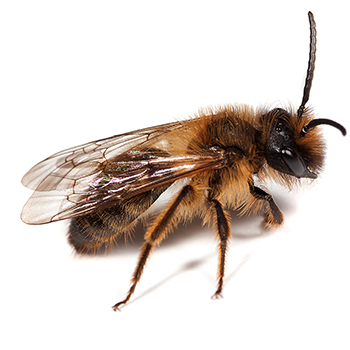Mining Bees

Your home or business should be a haven — a place you can relax, find peace of mind, and be productive. While some pests present specific threats to your health, all have the potential to disturb you or your customers. Mining bees are one such nuisance. Although they don’t carry disease or pose an imminent threat to the structure of your home or business, they can annoy and make life unpleasant for you, your loved ones, your pets and customers.
To protect your NJ, PA, MD, or DE home or business from mining bees, you need to learn about the behavior of this pest, take steps for prevention, and find effective treatment options should an infestation occur.
What Are Mining Bees?
Mining bees, sometimes nicknamed “chimney bees” are commonly found up and down the east coast of the U.S. These small, summertime bees help pollinate flowers and are generally friendly and non-aggressive unless they feel threatened. However, they can—and do—bite as a means of self-defense. A sting from a mining bee can cause serious health complications to someone with a bee allergy.
Even if no one in your home or business is allergic to bees, mining bee control can help make you and others feel more comfortable. To get rid of mining bees, it’s best to reach out to a pest control professional like Viking Pest.
How Do I Identify Mining Bees?
Viking Pest’s certified entomologist, Craig, explains mining bees are black and yellow, with a short, stocky, furry body. Even though they are similar in appearance to honey bees, mining bees are smaller and form their nests beneath the soil. To establish a place to lay their eggs, female mining bees dig a tunnel through the soil. While burrowing, they build a turret that is shaped like a chimney using loose soil. Therefore, if you see bees emerging from the ground from pencil-sized tunnels, you may have a mining bee infestation.
Pest control experts at Viking Pest explain mining bees may also form their nests between foundation stones or between timber or logs in barns and cabins. To identify mining bees in these areas, you can check to see if they return to a large, central nest. If so, you have another kind of bee on your hands because female mining bees build their own small, tunnel-shaped nest and don’t combine with others in a hive.
How Do I Get Mining Bees?
If you have mining bees, they most likely came to your home or business because they were attracted to dry soil. Mining Bees prefer dry soil as wet soil can prevent them from nesting.
What Are the Effects of Mining Bees in and Around My Home or Business?
Mining bees are a nuisance pest. They often fly just above the ground, around the ankles and shins of you and your guests or customers. Even though they rarely sting, their presence can make potential clients jittery and inspire fear in those living in your home. Male mining bees can sometimes form large, imposing swarms that hover over the ground for days at a time, explain exterminators at Viking Pest.
How Do I Prevent Mining Bees?
The best way to prevent mining bees is to consult a pest control professional. Otherwise, you may risk doing unnecessary damage to your NJ, PA, MD, or DE lawn, garden, or home. Because they nest underground instead of in a central hive, they can be hard to locate without damaging your landscaping or foundation. Pest control experts at Viking Pest are well trained at effectively controlling mining bees in NJ, PA, MD, and DE.















